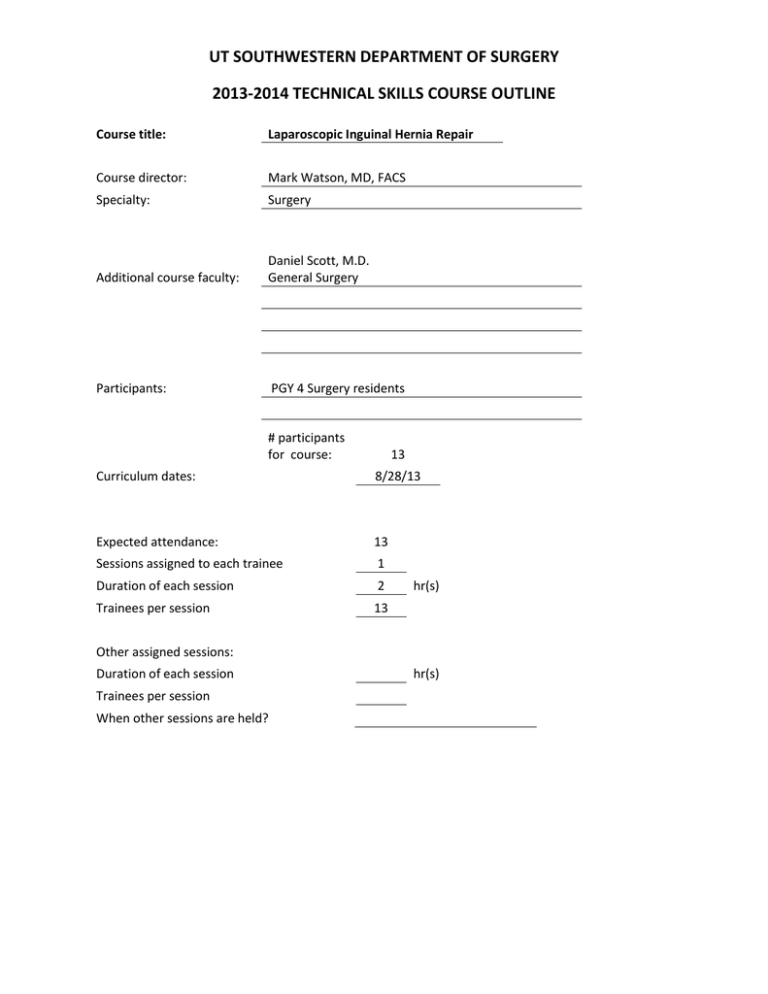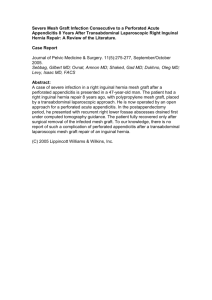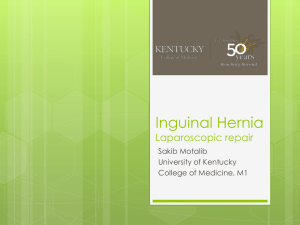UT SOUTHWESTERN DEPARTMENT OF SURGERY 2013-2014 TECHNICAL SKILLS COURSE OUTLINE
advertisement

UT SOUTHWESTERN DEPARTMENT OF SURGERY 2013-2014 TECHNICAL SKILLS COURSE OUTLINE Course title: Laparoscopic Inguinal Hernia Repair Course director: Mark Watson, MD, FACS Specialty: Surgery Additional course faculty: Daniel Scott, M.D. General Surgery Participants: PGY 4 Surgery residents # participants for course: 13 Curriculum dates: 8/28/13 Expected attendance: 13 Sessions assigned to each trainee 1 Duration of each session 2 Trainees per session 13 hr(s) Other assigned sessions: Duration of each session Trainees per session When other sessions are held? hr(s) UT SOUTHWESTERN DEPARTMENT OF SURGERY 2013-2014 TECHNICAL SKILLS COURSE OUTLINE Course Completion Verification - How do you know when a trainee has completed each component of the course and the overall course itself? Please specify for each course component, if applicable – for example, assigned reading component verified by written testing and skills component verified by attending 2 course-instructor led sessions. ☒ ☐ Attendance based: based on trainee attending all of the designated sessions ☐ Entire course - course solely based on attendance ☒ Part of course - attendance to designated sessions required in addition to other components listed below Repetition based: based on the trainee performing a specific number of repetitions Components: # of Repetitions: ☐ Proficiency based: based on the trainee performing a specified number of repetitions Components: Method for determining: ☐ Written testing: based on passing a written test Components: ☐ Documentation of watching videos/CD's/web-based materials: based on proctor or instructor verification that the trainee has watched the specified materials Components: ☐ Other (specify): Components: UT SOUTHWESTERN DEPARTMENT OF SURGERY 2013-2014 TECHNICAL SKILLS COURSE OUTLINE Self-study or self-practice (Is self-study or self-practice an expectation of this course?) ☒ No ☐ Yes Self-study component(s): Estimated time requirements for self-study: hrs Phase of course where self-study completed: Self-practice component(s): Estimated time requirements for self-practice: hrs Phase of course where self-study completed: Training Location(s): SCMIS Lab Resources (Textbooks, CD-ROMs, Videos, etc): Interactive CD-ROM or laparoscopic inguinal hernia repair BCR training video Educational Scope: ☒ ☒ ☒ Skills Components: Cognitive Components: Judgment Components: Peritoneal dissection for inguinal hernia repair, laparoscopic port insertion, placement of polypropylene mesh with tacking. Teaching access and dissection of the pre-peritoneal space, safe port insertion, safe dissection of peritoneum and spermatic cord, identification of important structures in the retroperitoneum, insertion of polypropylene mesh, fixing polypropylene mesh utilizing tacking device, cognitive teaching set up and preparation of patient for laparoscopic inguinal hernia surgery, standing anatomy, pre-peritoneal space as it applies to repair of inguinal hernia. Identifying appropriate patients for laparoscopic inguinal hernia repair vs. open inguinal hernia repair, understanding appropriate indications for conversion to open inguinal hernia repair. UT SOUTHWESTERN DEPARTMENT OF SURGERY 2013-2014 TECHNICAL SKILLS COURSE OUTLINE Learning Objectives: Understanding a selection of appropriate patient candidate for laparoscopic inguinal hernia repair. Understanding insertion of access for dissection of pre-peritoneal space. Safe insertion of laparoscopic instruments. Safe dissection of peritoneum and the pre-peritoneal space for mesh application. Safe insertion of mesh into the pre-peritoneal space. Appropriate positioning and fixation of mesh to myopectineal floor. Summary of Curriculum, Teaching Methods, and Resource Utilization: (For each component, please specify what material will be taught during each session, how will the material be taught, and what teaching materials will be used. Please also specify the overall format for the course including expectations required for successful course completion) Faculty introduction of VCR video training session. Introduction of CD-ROM for laparoscopic inguinal hernia repair. Faculty demonstration of pre-peritoneal dissection model on video trainer. Faculty demonstration of insertion of polypropylene mesh and fixation utilizing rubber model and video trainer. Skill session. Two resident teams assisting during pre-peritoneal dissection on video trainer model. Two residents assisting for insertion of polypropylene mesh and fixation. Visual evaluation of appropriate placement of mesh on rubber model. Methods for giving feedback to learners (Formative and Summative): Immediate faculty feedback by observation, faculty comments on individual performance. Methods of assessment of learners: Direct observation by faculty of peritoneal dissection and mesh placement. Methods for remediation: Continued one-on-one practice sessions with faculty Methods of course evaluation: Post-test questionnaires completed by trainees at the end of the course and faculty evaluations of skills sessions UT SOUTHWESTERN DEPARTMENT OF SURGERY 2013-2014 TECHNICAL SKILLS COURSE OUTLINE Materials: Hernia rubber model Peritoneal dissection model Rubber mesh placement model Laparoscopic instruments Tackers Mesh Dissection balloons





